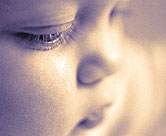 |
 |
 |
||
    |
||||
|
||||

Preventing Shaken Baby Syndrome
Parents who are prepared for infant's crying bouts can maintain better control, studies say|
|
HealthDay
By Robert Preidt
Thursday, March 5, 2009
 THURSDAY, March 5 (HealthDay News) -- An educational program for parents can help prevent shaken baby syndrome that's triggered by infant crying, according to American and Canadian studies.
THURSDAY, March 5 (HealthDay News) -- An educational program for parents can help prevent shaken baby syndrome that's triggered by infant crying, according to American and Canadian studies.
"Typically, crying begins within two weeks of birth, so it's imperative that new parents receive information and learn coping strategies," Dr. Fred Rivara, an investigator at the Harborview Injury Prevention and Research Center, vice chairman of pediatrics at the University of Washington in Seattle and co-author of the U.S. study said in a university news release.
He and his colleagues tested an educational program called "The Period of PURPLE Crying," which includes a 12-minute DVD and information booklet. The program -- designed to teach parents that infant crying is normal and can be frustrating for caregivers -- identifies several behaviors as normal:
- Crying increases, peaking in the second month, and then declines
- Unexpected periods of prolonged crying occur
- The infant is resistant to soothing
- A pained look appears on the baby's face
- Long crying bouts take place
- Crying bouts cluster in the evening and late afternoon
The U.S. study included 2,738 mothers of new infants. Half of them received the PURPLE material, and the others were given information about infant safety. The mothers who received the PURPLE materials scored six points higher in knowledge about crying and one point higher in knowledge about shaking, were 6 percent more likely to share information with caregivers about how to cope with the frustration of infant crying and were 7 percent more likely to warn caregivers about the dangers of shaking, the study found.
In the Canadian study, mothers who received PURPLE materials scored six points higher in knowledge about crying; were 13 percent more likely to share information with caregivers about how to deal with infant crying, were 13 percent more likely to share information about the dangers of shaking and were about 8 percent more likely to share information about infant crying.
The U.S. study was published in the March issue of the journal Pediatrics, and the Canadian study was published in the Canadian Medical Association Journal.
"Changing knowledge is a critical first step in changing behavior, and this is important public health work because the results show it's possible to change people's ideas about crying," said Dr. Ronald Barr, the lead author of both studies. Barr is director of community child health at the Child & Family Research Institute and a professor of pediatrics at the University of British Columbia.
In the United States, about 1,300 infants are hospitalized or die from shaken baby syndrome each year, and about 80 percent of those who survive suffer brain injury, blindness and deafness, fractures, paralysis, cognitive and learning disabilities or cerebral palsy, according to background information in the news release.
HealthDay
Copyright (c) 2009 ScoutNews, LLC. All rights reserved.
Related News:
More News on this Date
Related MedlinePlus Pages:
| Home | Health Topics | Drugs & Supplements | Encyclopedia | Dictionary | News | Directories | Other Resources | |
| Disclaimers | Copyright | Privacy | Accessibility | Quality Guidelines U.S. National Library of Medicine, 8600 Rockville Pike, Bethesda, MD 20894 National Institutes of Health | Department of Health & Human Services |
Date last updated: 06 March 2009 |
